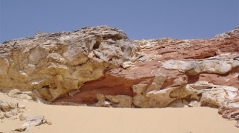

 Comptes Rendus Palevol
5 (8) - Pages 935-943
Comptes Rendus Palevol
5 (8) - Pages 935-943The timing of desertification of the Sahara Desert is poorly understood, with recent estimates indicating an onset of hyper-aridity during the Latest Miocene. Field work in Egypt in 2005 has led to the discovery of evidence that indicates that 11–10 Ma the Western Desert was covered in woodland. Fossiliferous cave breccia at Sheikh Abdallah, Western Desert, Egypt, has yielded a Late Miocene (11–10 Ma) microvertebrate fauna, which contains Galagidae, Microchiroptera, Macroscelididae, Soricidae, Erinaceidae, and Rodentia. The locality also yielded the remains of frogs, snakes, lizards, and birds. The fauna indicates a mean annual rainfall in excess of 500 mm and perhaps as much as 1,200 mm. This palaeoclimatic information is important because it reveals that the Sahara Desert, which is today the largest in the world, was either considerably smaller during the Late Miocene than it is today, or that it did not yet exist as a continuous hyper-arid belt right across the continent. This data accords with estimates of a Latest Miocene (8–7 Ma) increase in aridity in the Sahara.
Egypt, Galagidae, Late Miocene, Palaeoclimate, Sahara, Western Desert